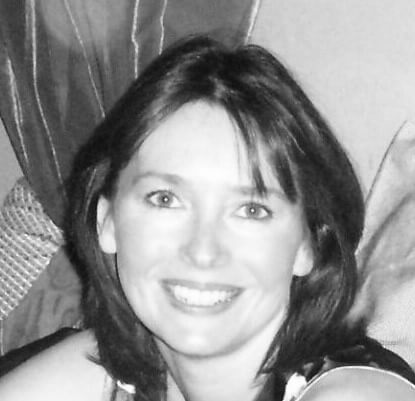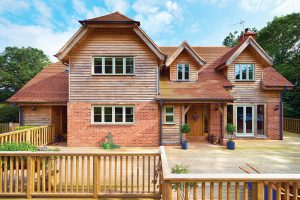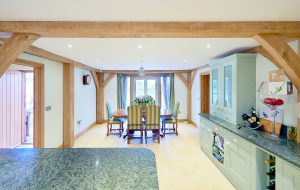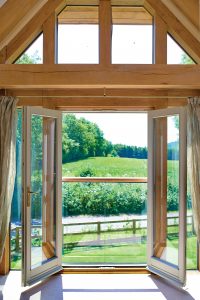Traditional Oak Frame & Brick Home
Purchasing a former egg farm was the start of David and Dawn Howard’s first ever self-build project, although at the time they were happy to live in a modest 1950s bungalow on the site. “We bought the property in 1992, together with a ramshackle wooden chicken house and assorted outbuildings,” says David, who is the managing director of a packaging and pallet company. “At first we rented out the property and later we moved in and lived there ourselves.”
The bungalow came with an agricultural tie, but as the farm had long since ceased to operate, the couple decided to apply to the local council for the tie to be lifted, and this was granted without objection. “Once it was removed we began considering replacing the old bungalow with a new house for ourselves,” says Dawn.
The Howards were introduced to oak houses at a self-build event where they met Tim Crump, managing director of Oakwrights, which designs and builds bespoke, jointed and pegged oak frame homes. The firm uses cutting-edge technology to create a very traditional product, working with sophisticated software that allows clients to interact with their frames in 3D virtual reality.
- NameDavid & Dawn Howard
- LocationBerkshire
- ProjectSelf-build
- StyleTraditional
- Construction methodOak frame
- House size278m² (2,988ft²)
- Build cost£506,700
- Build cost per m²£1,823
- Construction time24 weeks
- Current value£850,000
Tim was keen for the Howards to visit Oakwrights’ dedicated show home to experience an oak frame property first hand; duly impressed, they pressed on with plans to use this construction method to realise their goal.
The planning process
Once again the Howards approached their local council to discuss the possibility of replacing the bungalow, using plans and elevations taken directly from the show home for illustrative purposes. This time the response was favourable, and the planners were keen to see a totally one-off design – preferring a one-and-a-half storey barn-style property that would respond to the rural location.
“We asked Tim to recommend a designer who could help us through the process, and he introduced us to John Williams, one of Oakwrights’ architectural designers,” says David. “John visited the site and listened to our brief before putting forward an initial proposal. There were some revisions – the garage was turned into a utility room with space above for an ensuite wetroom for the master bedroom – and a formal planning application was then made.”
Additional information was required about the site, including a visual impact appraisal and a landscaping plan – which involved erecting post and rail fencing and planting indigenous hedging. Design and access statements were also prepared, and planning approval was subsequently granted for the Howards’ new home.
Defining elements
Based around three main bays, the downstairs layout includes a large sitting room leading on to a rear entrance hall, a TV snug, open plan kitchen/dining room, utility room and two cloakrooms. The upstairs layout has four bedrooms, a family bathroom, a master ensuite and a dressing room on the first floor.
Two of the house’s three bays are defined externally by large dormer windows, while the gable-ended third bay is fully glazed. To the front and rear are oak frame porches that hint at the full post-and-beam arrangement within. Externally, the natural materials used will gently mellow and allow the house to settle into its surroundings.
Making space
In August 2011 the old bungalow was demolished and the site cleared in readiness for new foundations and a concrete slab. The oak frame was then delivered on 31 October, and five days later it was completed.
The Oakwrights team worked from 7am until late in the evenings using floodlights and a mammoth crane that was visible from miles around. A second-hand log cabin, purchased locally for £500 and erected by Dawn and David, served as a cosy site hut for the crew.
Sample panels of brickwork were required by the planners and the Howards visited various local houses to get a sense of the vernacular options and to help them to visualise the end result. They chose Flemish bond for the brickwork, a traditional look that was further enhanced by the use of ‘double struck’ pointing, where the mortar is indented at the top and bottom of the joint, a style associated with heritage brick buildings.
Grey zinc-coated guttering sits alongside oak soffits and barge rafters, complementing the muted green of the windows and doors – a colour that blends well with the handmade bricks, clay plain tiles and oak weatherboarding.
Expert help
“We were really glad we chose a small, family-run local building company,” says Dawn. “Our main contractor, Andrew Uprichard uses the same team of groundworkers, electricians, plumbers, plasterers, painters and roofers, and his craftsmen should feel very proud of what they’ve achieved here. The build ran smoothly and was finished to the high standard we were expecting.”
An independent project manager was employed to oversee the build, who visited the site at least once a week and helped to ensure that everything ran smoothly.
Dawn and David spent a great deal of time considering which environmentally friendly features and gadgets to purchase. In the end they chose solar thermal panels, which are incorporated within the roof and provide hot water.
“I was worried about their impact on the look of the house, but the panels have been fixed horizontally rather than vertically, which helps,” says Dawn. The couple also have an air source heat pump and a rainwater harvesting tank, which feeds the toilets and the washing machine.
Final details
Internally the oak frame was cleaned by hand using oxalic acid, because David and Dawn felt that sandblasting the beams would result in too rough a texture. This labour-intensive task was repeated for a second time by a specialist company recommended by Oakwrights in order to achieve the effect Dawn and David wanted.
The timbers were then finished with a light coating of beeswax in most rooms, while Osmo oil was used for the bathrooms. “Oak is a natural material that shrinks as it dries out,” says David, “so there will always be cracking and movement with an oak building over the first few years – although it won’t affect its structural stability. We also had some tannin streaks where the wood got wet.”
The couple retained as many trees on site as possible and have also undertaken some new planting, including beech hedges intermingled with roses, as well as creating some more natural-looking area of long grass and mown pathways. They keep their two horses in the paddocks and thoroughly enjoy their new life in this peaceful rural setting.
“Building the house was definitely a challenge, but we are extremely happy with the result,” says Dawn. “It’s been said by visitors that our house has a friendly, welcoming feel, and we say to each other on a regular basis how much we love living here. It’s always a real pleasure to come home to.”

































































































 Login/register to save Article for later
Login/register to save Article for later





















